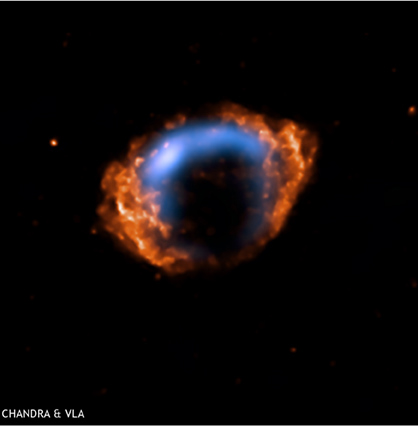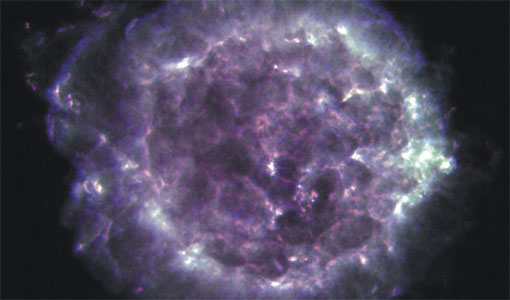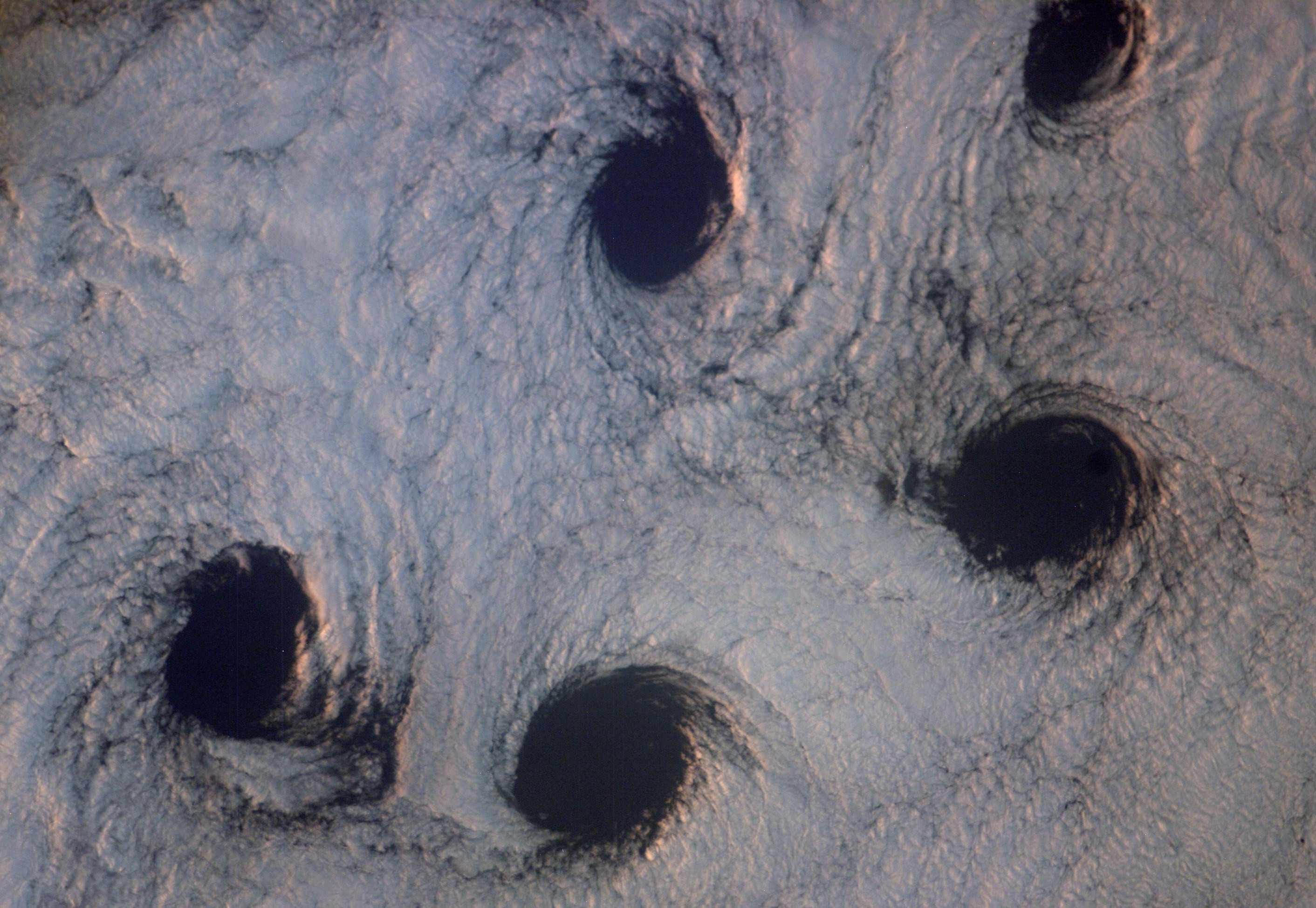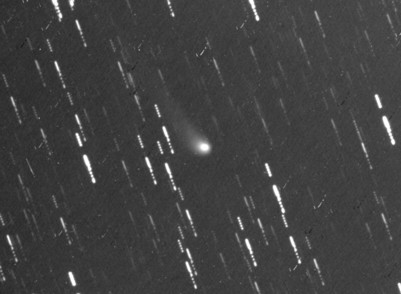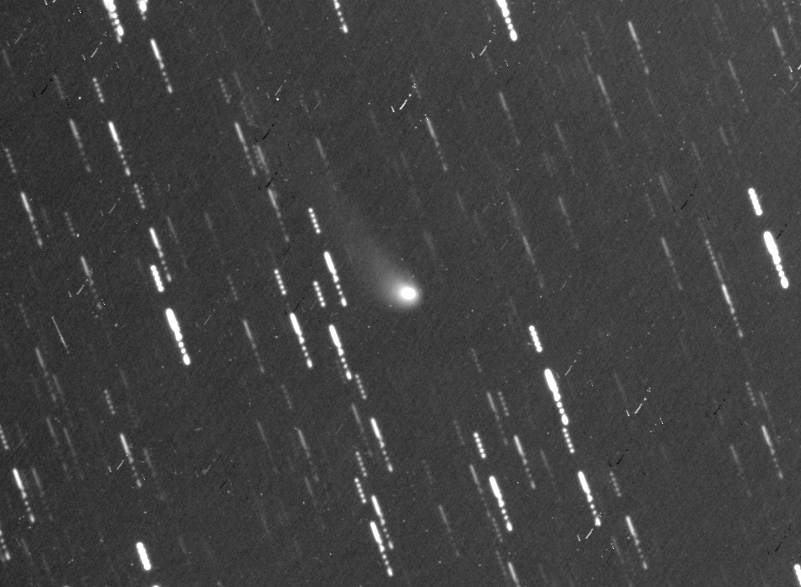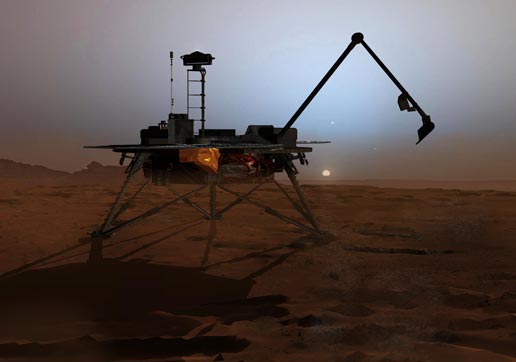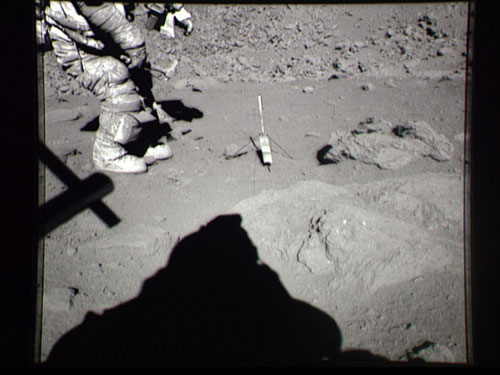
A new NASA-led study shows human-caused climate change has made an impact on a wide range of Earth’s natural systems, including permafrost thawing, plants blooming earlier across Europe, and lakes declining in productivity in Africa. Researchers at NASA’s Goddard Institute for Space Science and 10 other institutions have linked varying impacts since 1970 with rises in temperatures during that period. “Humans are influencing climate through increasing greenhouse gas emissions,” said Cynthia Rosenzweig, lead author of the study. “The warming is causing impacts on physical and biological systems that are now attributable at the global scale and in North America, Europe, and Asia.”
Continue reading “New NASA Study Links Humans to Changes On Earth”
The Big Announcement: Chandra, VLA Find Youngest Supernova in Our Galaxy
Astronomers have found the remains of the youngest supernova, or exploded star, in the Milky Way Galaxy. The supernova occurred in 1868, but was hidden behind a thick veil of gas and dust. Using the Very Large Array (VLA) and NASA’s Chandra X-Ray Observatory, which could peer through the veil, astronomers have now found “G1.9+0.3,” the first example of what scientists believe are a “missing population” of young supernova remnants. This is NASA’s long awaited announcement, and astronomers have been searching for over 50 years for this type of young supernova.
From observing supernovae in other galaxies, astronomers estimate that about three such stellar explosions should occur in our Milky Way every century. However, the most recent one known until now occurred around 1680, creating the remnant called Cassiopeia A. The newly-discovered object is the remnant of an explosion only about 140 years ago.
“It’s great to finally track one of them down,” said David Green of the University of Cambridge in the UK, who led the VLA study.
Supernovas mark the violent death of a star, and release tremendous amounts of energy and spew heavy elements such as calcium and iron into interstellar space. This seeds the clouds of gas and dust from which new stars and planets are formed.
The lack of evidence for young supernova remnants in the Milky Way had caused astronomers to wonder if our Galaxy, which appears otherwise normal, differed in some unknown way from others, or if our understanding of the relationship between supernovae and other galactic processes was in error.
Cassiopeia A supernova remnant — from the year 1680.
The astronomers made their discovery by measuring the expansion of the debris from the star’s explosion. They did this by comparing images of G1.9+0.3, made more than two decades apart.
In 1985, astronomers led by Green observed G1.9+0.3 with the VLA and identified it as a supernova remnant. At that time, they estimated its age as between 400 and 1,000 years. It is near the center of our Galaxy, roughly 25,000 light-years from Earth.

In 2007, another team of astronomers, led by Stephen Reynolds of North Carolina State University, observed the object with the Chandra X-Ray Observatory. To their surprise, their image showed
the object to be about 16 percent larger than in the 1985 VLA image.
“This is a huge difference. It means the explosion debris is expanding very quickly, which in turn means the object is much younger than we originally thought,” Reynolds explained.
However, this expansion measurement came from comparing a radio image to an X-ray image.
To make an “apples to apples” comparison, the scientists sought and were quickly granted observing time on the VLA which confirmed the supernova remnant’s rapid expansion.
The object already has provided surprises. The velocities of its explosion debris and extreme energies of its particles are unprecedented. “No other object in the Galaxy has properties like this,” said Reynolds. “Finding G1.9+0.3 is extremely important for learning more about how some stars explode and what happens in the aftermath.”
Original News Sources: Chandra site , National Radio Astronomy Observatory
This Week’s “Where in the Universe?” Challenge
Here’s your image for this week’s “Where in the Universe?” challenge. Take a look at the image and before proceeding to the end of this post, make your guess as to what location in the universe is represented here. It could be anywhere — nothing is off limits for this challenge! Near or distant, far and wide, Universe Today spares no expense when it comes to searching for unique and unusual images to test your visual knowledge of our universe! Give yourself an extra point for guessing (or knowing) the feature shown here, and another point for naming the spacecraft that took this image. Just a couple more ticks on the timer here before revealing the awesome power of this week’s image….
Have you made your guess?
Here’s the answer:
These are cloud vortices found near Alaska, here on Earth. These are called von Karman cloud vortices, named after Theodore von Karman, co-founder of the Jet Propulsion Laboratory. These vortices near the Aleutian Islands were photographed by an Expedition 15 crewmember on the International Space Station. The vortices are created by the wind encountering a barrier such as an island, then changing direction and velocity and forming eddies in the wind and subsequently, in cloud patterns. The image was taken almost a year ago, on May 23, 2007 and the location of the image is at 51.1 degrees north latitude and 178.8 degrees west longitude.
In the cloud image above, the islands disturb the wind flow. As a prevailing wind encounters the island, the disturbance in the flow propagates downstream of the island in the form of a double row of vortices which alternate their direction of rotation. The animation below (courtesy of Cesareo de la Rosa Siqueira at the University of Sao Paulo, Brazil) shows how a von Karman vortex develops behind a cylinder moving through a fluid.

For you camera buffs out there, the image was taken with a Kodak DCS760C Electronic Still Camera.
How’d you do?
Original Source: Gateway to Astronaut Photography of Earth
Comet C/2005 L3 McNaught Brighter Than Expected
According to the estimations made by the IAU (International Astronomical Union) and ICQ (International Comet Quarterly) information, Comet C/2005 L3 McNaught wasn’t supposed to be any brighter than magnitude 15 this month and in a slow decline in brightness. However, thanks to observations done by Joseph Brimacombe at Macedon Ranges Observatory, the “tale of the tape” shows a different story…
Currently located in Hercules (RA 16 16.65 Dec +20 12.8), recent observation estimates of around magnitude 13 have been confirmed thanks to Mr. Brimacombe’s photographic artistry. The ICQ reports have shown Comet C/2005 L3 McNaught slowly brightening since mid-March. Discovered on June 3, 2005 by R. H. McNaught of Siding Spring, the then 17.7 magnitude comet has slowly climbed the brightness ladder over the last 3 years. Reaching perihelion this year on January 16, L3 McNaught has surprised many astronomers – including observers.
Click On Image for Comet Movie – Courtesy of Macedon Ranges Observatory
Says Brimacombe – who was remotely controlling the telescope from his location in Abu Dhabi: “I took a few shots for fun and was surprised at how bright it was compared with barely visible Comet 110P Hartley (mag. 15.5). McNaught was supposed to be mag 15 and it’s easy to see the tail.”
Will Comet C/2005 L3 McNaught brighten as dramatically as Comet Holmes did? Chances are slim, but comets are mysterious creatures that seldom do what we expect them to. According to all the reports, L3 McNaught has great high surface brightness properties right now which will make it easier than most faint comets to spot with backyard equipment. Who knows what tomorrow might bring?
AVI and Still Photo Information:
Looking for Black Holes in Water?

Looking for Hawking Radiation in space is likely impossible with our current technology. But scientists here on Earth recently used flowing water to simulate a black hole and create event horizons, testing Stephen Hawking’s famous prediction that the event horizon creates particles and anti-particles.
Continue reading “Looking for Black Holes in Water?”
Vatican Astronomer Says Its OK to Believe in ET
The director of the Vatican observatory said it’s possible that intelligent life exists on other planets. And since aliens would be part of God’s creation, their existence would not contradict the Catholic faith. In an interview with the Vatican newspaper Rev. Jose Gabriel Funes discussed the Big Bang theory, as well as creation and evolution. The interview was originally published in Italian, but a priest from Holland translated the full interview to English and posted it on his website, FatherRoderick.com:
Continue reading “Vatican Astronomer Says Its OK to Believe in ET”
Imminent Discovery of Life On Mars?
Do you think there is life on Mars? Do you think Phoenix will find evidence of it? Now there’s a blog that’s trying to collect a snapshot of the opinions of scientists, amateurs, and everyday people. “Imminent Discovery” thinks Phoenix may find simple life. Finding this evidence will definitely become headlines… If it happens. Is it possible it might have originated from earth? Perhaps from space, like the famous Antarctica meteorite which was believed to contain evidence of life transported here from Mars?
According to Richard Trentman, a Minor Planet Coordinator at Powell Observatory, “The idea of life in some form on other planets, I believe is highly probable. I have studied about the extreme places on this planet where life has been found and many are far more extreme than may be found on Mars and other planets or moons in our solar system. I believe that anyone that thinks life cannot be “out there” has their eyes closed and blinders on.”
Over time, many astronomers have spent a lifetime dreaming of life and formations on Mars like the misguided Slipher: “Some form of vegetation exists. …The evidence is in the blue-green areas and the changes in their appearance. Vegetation would present exactly the appearance shown, and nothing we know of but vegetation could. The season change that sweeps over them is metabolic…” And yet others take more pragmatic views like astronaut Pete Conrad who commented on bacteria surviving on retrieved Surveyor III remains: “The most significant thing we ever found on the whole Moon was that little bacteria who came back and lived an nobody ever said (anything) about it.”
What’s your opinion? Help to update the book “Imminent Discovery, NASA’s Phoenix and the Secret of Life on Mars” in a post-discovery edition with some of these inputs. Please feel free to Post Your Thoughts On The Imminent Discovery of Life On Mars. Responses may be anonymous or you may use initials if you prefer. To make it more interesting, there is a random drawing of all individuals who enter comments to give away one copy of the classic 1962 book by Earl Slipher “Mars, the Photographic Story”, and a competition between astronomy clubs. Have fun!
Phobos Might Only Have 10 Million Years to Live
You can breathe easily. The Moon is slowly receding away from the Earth at a rate of 3.7 cm/year (1.5 in/yr). But the Martians aren’t so lucky. Their moon Phobos is known to be doing exactly the opposite. It’s spiraling inward, and in the distant future it will crash into the surface of Mars. Researchers originally thought that Phobos has about 50 million years to go, but an Indian researcher has re-run the calculations and thinks Phobos only has about a quarter of that time to live.
It was originally believed that Phobos would take about 50 million years to crash into the surface of Mars, but according to Bijay Kumar Sharma, an Assistant Professor at the National Institute of Technology in Bihar, India, it might happen much more quickly. Dr. Sharma has revised the calculations for Phobos’ destruction in his new paper, Theoretical Formulation of the Phobos, moon of Mars, rate of altitudinal loss.
According to Sharma, Phobos will actually be destroyed about 10.4 million years from now, and not the 50 million years the researchers had previously calculated.
Phobos is believed to be an asteroid that Mars captured early on in its history. it’s one of the least-reflective objects in the Solar System, and thought to be similar to a D-type asteroid. It currently orbits Mars at an altitude of about 9,380 km (or about 6,000 km above the Martian surface).
Why does the Earth’s moon spiral outward, while Phobos is spiraling inward to Mars?
The Moon formed billions of years ago when a Mars-sized object crashed into Earth and sprayed material into orbit. This material pulled back together from mutual gravity to form the Moon, and this debris received a gravitational slingshot from the Earth.
They key is that the material was tossed into a high enough orbit, above what’s known as the synchronous orbit. This is where the Moon completes an orbit slower than the Earth takes to rotate once. Since the Moon ended up higher than this orbit, it’s spiraling outward. If its orbit was less than the length of a day, it would spiral inward.
And this is what has happened to Phobos. It orbits below this synchronous orbit, where it completes an orbit around Mars faster than the planet itself turns. It’s spiraling inward instead of outward.
Once Phobos gets down to an altitude of only 7000 km above the center of Mars (or 3,620 km above its surface), it will enter what’s known as the Roche limit. At this point, the tidal forces of Mars will tear Phobos apart, turning it into a ring that will continue to spiral into Mars. According to Dr. Sharma, this will happen in only 7.6 million years from now.
To know exactly how long Phobos has to live, Dr. Sharma suggests that a mission should be sent to Phobos to land on its surface and then use radar to measure the changing distance to Mars.
Original Source: Arxiv
Rising Temperatures Could Shut Down Plate Tectonics
Venus is known as the Earth’s twin, but a better name might be Earth’s “evil twin” planet. Although Venus has a similar size and mass to Earth, it has a dramatically different surface and atmosphere. And one of the biggest differences is that fact that Earth has plate tectonics, and Venus doesn’t. New research indicates that prolonged atmospheric heat might be able to shut down plate tectonics, and cause our planet’s crust to be locked in place. Don’t worry, this isn’t something we’ll have to worry about for a few hundred million years.
This research was done by scientists from the US, Canada and Australia, and published in this week’s edition of the journal Earth and Planetary Science Letters. According to the researchers, large amounts of volcanic activity or increases in the Sun’s luminosity could reach a tipping point, where the system of plate tectonics just shuts down.
Don’t worry, this isn’t an article about the dangers of global warming. The kind of temperatures we’re talking about here are beyond anything scientists are expecting from human-induced climate change.
These findings help explain why Venus might have evolved differently from Earth. Although the planet has a very similar size and geological makeup, the atmosphere on Venus is rich in carbon dioxide, and almost 100 times more dense. It acts like a blanket, trapping heat from the Sun, and raising temperatures to more than 450 °C.
Plate tectonics are very important for keeping our mild temperatures here on Earth. The carbon dioxide is pulled out of the air and trapped on the floor of the ocean. This carbon gets returned to the interior of the Earth when a free-floating sections of crust called tectonic plates slide underneath one another.
Scientists think that the Earth’s plate tectonics are stable and self-correcting, assuming excess heat from inside the Earth can escape through the crust. The flowing mantle keeps the tectonic plates moving.
But if the surface of the Earth is heated up for a long period of time, it could make the flowing mantle more viscous, so it stops flowing. This would shut down plate tectonics on Earth.
“We found the Earth’s plate tectonics could become unstable if the surface temperature rose by 38 °C (100 °F) or more for a few million years,” said lead author Adrian Lenardic, associate professor of Earth science at Rice University. “The time period and the rise in temperatures, while drastic for humans, are not unreasonable on a geologic scale, particularly compared to what scientists previously thought would be required to affect a planet’s geodynamics.”
One interesting discovery is that the rise in temperature doesn’t need to boil away the Earth’s oceans. The tectonic shut down could happen, even though there’s still liquid water on the surface of Earth.
Original Source: Rice University News Release
Lower Gravity Will Help Lunar Dust Get Deep Into Astronaut Lungs
Dusting the house might be a chore here on Earth, but when astronauts return to the Moon, they’ll need to be neat freaks. Their lives might depend on it! According to researchers at the National Space Biomedical Research Institute, the health of lunar astronauts will depend on how well they can keep the fine lunar dust out of the air.
During the Apollo lunar missions in the 1960s and 1970s, astronauts realized how much this lunar dust was a hassle to their exploration of the Moon. The tiny particles clung to everything, and when the astronauts returned to their lander, it made a real nuisance. By the end of their missions, the astronauts said there was so much dust in their vehicles that they could smell it.
There are no known illnesses associated with the dust today; but the astronauts just weren’t exposed to it long enough. But scientists studying it back on Earth found that the dust was very similar to fresh-fractured quartz, which is highly toxic to humans. When astronauts return to the Moon in the next decade, they could be on the Moon for months, and exposed to much larger quantities of the dust.
And there’s another problem. Because of the reduced gravity on the Moon, and the tiny size of the dust particles, our respiratory system might not be able to handle the particles as well as we do on Earth. Here’s Dr. Kim Prisk, an adjunct professor in the Department of Medicine at the Department of Medicine at the University of California, San Diego:
“In the moon’s fractional gravity, particles remain suspended in the airways rather than settling out, increasing the chances of distribution deep in the lung, with the possible consequence that the particles will remain there for a long period of time.”
To conduct their research, the scientists are taking participants on NASA’s Microgravity Research Aircraft. This is a special aircraft that flies on a parabolic path. At the height of each arc, people on board the aircraft experience a brief period of low gravity, or even weightlessness.
When the gravity is lowered to the same as the Moon, the participants breath in small particles, which the researchers then study as they move down the airways. They want to know how many end up in the lungs. The deeper the dust goes into the lungs, the more dangerous it’ll be.
Again, here’s Dr. Prisk:
“With the reduced-gravity flights, we’re improving the process of assessing environmental exposure to inhaled particles. We’ve learned that tiny particles (less than 2.5 microns) which are the most significant in terms of damage, are greatly affected by alterations in gravity.”
The next step will be to figure out how to limit the amount of exposure to the dust. The more dangerous the dust is, the more complicated an engineering task it will be to keep it all out.
Original Source: NSBRI News Release

